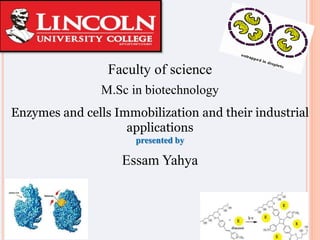
Enzyme Immobilization_ 2
- 1. Faculty of science M.Sc in biotechnology Enzymes and cells Immobilization and their industrial applications presented by Essam Yahya
- 2. INTRODUCTION Enzymes are sensitive, unstable biocatalysts: needs water to perform Not ideal catalysts and somewhat undesirable in most of the synthesis process Industry needs a stable catalysts. Immobilization can make the enzyme or the active cells stable and less sensitive toward environment What is immobilization?
- 4. Advantages of Immobilized Enzymes/ cells
- 5. WHY USE IMMOBILIZED ENZYME / CELLS ? Enable to employment of enzyme: In different solvent At extreme of pH and temperature Exceptionally high substrate concentration It can also modify the following things at the same time: Substrate specifity Enantioselectivity and Reactivity
- 6. PROPERTIES OF THE IDEAL CARRIER REQUIRED FOR ENZYME / CELLS IMMOBILIZATION 1- Inertness 2- Physical strength. 3- Stability. 4- Cost low and of optimum quality. 5- Regenerability. 6- Reduction in product inhibition. 7- Enhancement of enzyme specificity.
- 8. (1) ADSORPTION Physical Adsorption of enzyme protein on the surface of water-insoluble carriers. Advantages : no reagents and only a minimum of activation steps are required. Disadvantages : the adsorbed enzyme may leak from the carrier during use due to a weak binding force between the enzyme and the carrier. Moreover, the adsorption is non-specific, further adsorption of other proteins or other substances. ADVANTAGES DISADVANTAGES 1. Simple and economical 1. Relatively low surface area for binding. 2. Limited loss of activity 2.Exposure of enzyme to microbial attack. 3. Can be Recycled, Regenerated & Reused 3. Yield are often low due to inactivation and desorption.
- 9. (2) COVALENT BINDING Based on the binding of enzymes and water-insoluble carriers by covalent bonds. The functional groups that may take part in this binding maybe an Amino group, Carboxyl, Sulfhydryl, Hydroxyl…etc Advantages : the binding force between enzyme and carrier is so strong that no leakage of the enzymes occurs, even in the presence of substrate or solution of high ionic strength. ADVANTAGES DISADVANTAGES 1. Strong binding, and No leakage of the enzymes occurs. 1. may alter the conformational structure and active center of the enzyme 2. even in the presence of substrate or solution of high ionic strength, no leakage occurs. 2- major loss of activity and/or changes of the substrate.
- 10. (3) IONIC INTERACTIONS Of the enzyme protein to water-insoluble carriers containing ion-exchange residues Polysaccharides and synthetic polymers having ion-exchange centers are usually used as carriers. Advantages : the enzyme to carrier linkages is much stronger for ionic binding. Disadvantages : the binding forces between enzyme proteins and carriers are weaker than those in covalent binding. ADVANTAGES DISADVANTAGES 1. the enzyme to carrier linkages is much stronger for ionic binding. 1. the binding forces between enzyme proteins and carriers are weaker than those in covalent binding. 2. Relatively not expensive. 2. Not suitable for many applications.
- 11. (4) CROSS LINKING Either to other protein molecules or to functional groups on an insoluble support matrix. Advantages : It is used mostly as a means of stabilizing adsorbed enzymes and also for preventing leakage from polyacrylamide gels The most common reagent used for cross-linking is glutaraldehyde. Disadvantages : Cross-linking reactions are carried out under relatively severe conditions. These harsh conditions can change the conformation of active center of the enzyme; and so may lead to ADVANTAGES DISADVANTAGES 1. Very little desorption ( enzyme strongly bound). 1. Cross linking may cause significant changes in the active site. 2. Higher stability (i.e.pH, ionic & substrate concentaration) 2. Not cost effective.
- 12. (5) ENTRAPMENT This method differs from the covalent binding and cross linking in that the enzyme itself does not bind to the gel matrix or membrane. This results in a wide applicability Advantages : Loss of enzyme activity upon immobilization is minimized. Disadvantages : The enzyme can leak into the surrounding medium. Another problem is the mass transfer resistance to substrate and products. ADVANTAGES DISADVANTAGES 1. No chemical modification. 1. The enzymes may leak from the pores. 2. Relatively stable forms. 2- Substrate can not diffuse deep in to the gel matrix. 3. Easy handling and reusage. 3- the mass transfer resistance to substrate and products.
- 14. COMPARISON BETWEEN THE METHODS
- 15. INDUSTRIAL APPLICATIONS OF ENZYME AND CELL IMMOBILIZATION Biomedical applications : diagnosis and treatment of many diseases. food industry: enzymes like pectinases and cellulases immobilized on suitable carriers are successfully used in the production of jams ,jellies. Production of bio-diesel from vegetable oils : Lipase catalyses the reaction with less energy requirements and mild conditions required which results in repeated use and stability . Waste water management: treatment of sewage and industrial effluents by used immobilized enzymes like preoxidases and laccase. Textile industry: The immobilization enzymes such as cellulase, amylase, pectinase are used for various textile applications such as scouring, biopolishing , denim finishing .
- 16. Detergent industry: The detergent industry also employs enzymes for removal of stains. The enzymes used in detergent industry are: - Protease which is used to remove the stains of blood, egg. - Amylase used to remove the starch and Lipase used to remove the stains of oil. In diary industry the immobilized enzymes are used to coagulate the milk protein during cheese making and to treat the waste whey. In pharmaceutical industry, immobilized enzymes are used in enzyme therapy. - The asparginase is covalently bound with zinc ions and used in treatment of leukaemias. - Zinc ions are used to enhance treatment of diabetes, by increasing the survivability and reaction potential of the insulin.
- 17. More of Important Applications
- 18. Q1 What's the meaning of immobilization, mention the advantages of it ? Q2 what's the immobilization Techniques ?
- 19. THANK YOU